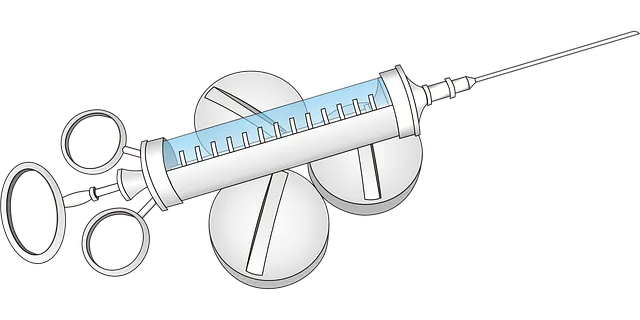Semaglutide, an effective GLP-1 receptor agonist for type 2 diabetes management and weight loss, starts with a low dose (0.25 mg or 0.5 mg) administered weekly via injection, gradually increasing as needed based on patient responses and glucose control. Regular HbA1c monitoring guides dosing adjustments, aiming to balance blood sugar levels while mitigating common side effects like nausea. Consistent monitoring, storage per manufacturer guidelines, and adherence to prescribed dosages are crucial for safe and effective long-term semaglutide therapy.
“Discover the ins and outs of semaglutide dosing with our comprehensive guide. Semaglutide, a groundbreaking medication, aids in weight management and type 2 diabetes treatment. Understanding its proper dosage is key to maximizing benefits while minimizing risks.
From initial starting doses and frequency adjustments to long-term considerations, this article covers all bases. Learn about potential side effects, blood sugar monitoring, and practical storage tips.
Master the art of semaglutide dosing for optimal health outcomes.”
Understanding Semaglutide and Its Uses

Semaglutide is a medication primarily used for the treatment of type 2 diabetes and weight management. It belongs to a class of drugs known as glucagon-like peptide-1 (GLP-1) receptor agonists, which mimic the effects of a natural hormone in your body. By stimulating these receptors, semaglutide helps regulate blood sugar levels, promotes feelings of fullness, and reduces appetite, making it an effective tool for both diabetes control and weight loss.
Understanding the correct semaglutide dosing is crucial for optimal results and to avoid potential side effects. The dosage typically starts low and gradually increases over time to minimize gastrointestinal discomfort, a common side effect. This medication is usually administered once weekly by injection, allowing for convenient long-term management of diabetes and supporting patients in their weight loss journeys.
Determining Starting Dose and Frequency

When initiating semaglutide therapy, the starting dose and frequency are critical factors that depend on various patient characteristics and medical conditions. Healthcare providers typically begin with a low dose to minimise potential side effects, especially during the first few weeks of treatment. The recommended initial dose is often around 0.25 mg or 0.5 mg, administered subcutaneously once weekly, depending on the patient’s baseline glycemic control.
The dosing frequency may be adjusted based on individual responses and the patient’s glucose management goals. For some patients, a weekly injection might suffice, while others may require more frequent administration, such as every 2 days or even daily, to achieve optimal blood sugar regulation. Regular monitoring of hemoglobin A1c (HbA1c) levels is essential to guide these adjustments, ensuring that the semaglutide dose aligns with the patient’s metabolic needs.
Adjusting Doses Based on Individual Response

Semaglutide dosing is a delicate balance, and one that requires careful consideration of each patient’s unique response. While initial doses are often prescribed based on standard guidelines, it’s crucial to monitor patients closely for their individual reactions. Some individuals may require higher or lower dosages than initially recommended, highlighting the importance of personalized medicine in semaglutide therapy.
Adjusting semaglutide dosing should be done incrementally and with professional medical guidance. If a patient experiences adverse effects like nausea or vomiting, healthcare providers can temporarily reduce the dose or switch to a slower injection frequency. Conversely, if blood sugar levels remain elevated despite adequate dosing, an increase in medication quantity might be necessary. Regular follow-ups allow for these adjustments, ensuring optimal semaglutide dosing tailored to each user’s needs.
Common Side Effects and When to Consult a Doctor

Semaglutide, while effective in weight management, can cause several common side effects, especially during the initial stages of treatment. These may include nausea, vomiting, diarrhea, and stomach pain – typically mild and transient. In some cases, patients might experience decreased appetite or constipation. It’s important to remember that these are usually manageable and often resolve as your body adjusts to the medication.
If side effects persist, worsen, or significantly impact your daily life, it’s crucial to consult a healthcare professional. They can provide guidance on managing symptoms and may adjust your semaglutide dosing regimen if necessary. Additionally, seek medical advice if you experience any concerning symptoms like severe nausea accompanied by dehydration, rapid heart rate, or signs of allergic reaction. Regular monitoring by a doctor is essential to ensure safe and effective use of semaglutide dosing.
Monitoring Blood Sugar Levels Regularly

Regular monitoring of blood sugar levels is an integral part of managing semaglutide therapy. Patients should aim to check their glucose levels frequently, as recommended by their healthcare provider, to ensure optimal dosing and prevent potential complications. This meticulous practice allows for a deeper understanding of one’s body response to semaglutide, facilitating adjustments in medication administration.
By keeping a close eye on blood sugar readings, users can identify patterns and make informed decisions regarding their semaglutide doses. It is crucial to maintain a consistent routine for testing, using reliable equipment, and recording the results accurately. This data will empower patients and healthcare professionals alike to tailor the semaglutide dosing regimen, ensuring it aligns perfectly with individual metabolic needs.
Long-term Dosage Considerations and Storage Tips

When considering long-term semaglutide dosing, it’s crucial to maintain a consistent and regular schedule. This hormone-like medication, used primarily for type 2 diabetes management, requires careful monitoring by healthcare professionals. Dose adjustments are often based on individual responses, blood sugar levels, and potential side effects. Patients should adhere to prescribed dosage instructions, avoiding sudden changes or skipping doses, as this can lead to adverse events.
For optimal storage, semaglutide vials or pens should be kept in a cool, dry place, away from direct sunlight. It is essential to follow the manufacturer’s guidelines for proper storage conditions and expiration dates. Never freeze the medication. If you’re not planning to use it immediately, store it in its original container, ensuring the needle and pen cap are secured to prevent accidental exposure. This careful handling ensures the potency and safety of the semaglutide dosing regimen.
